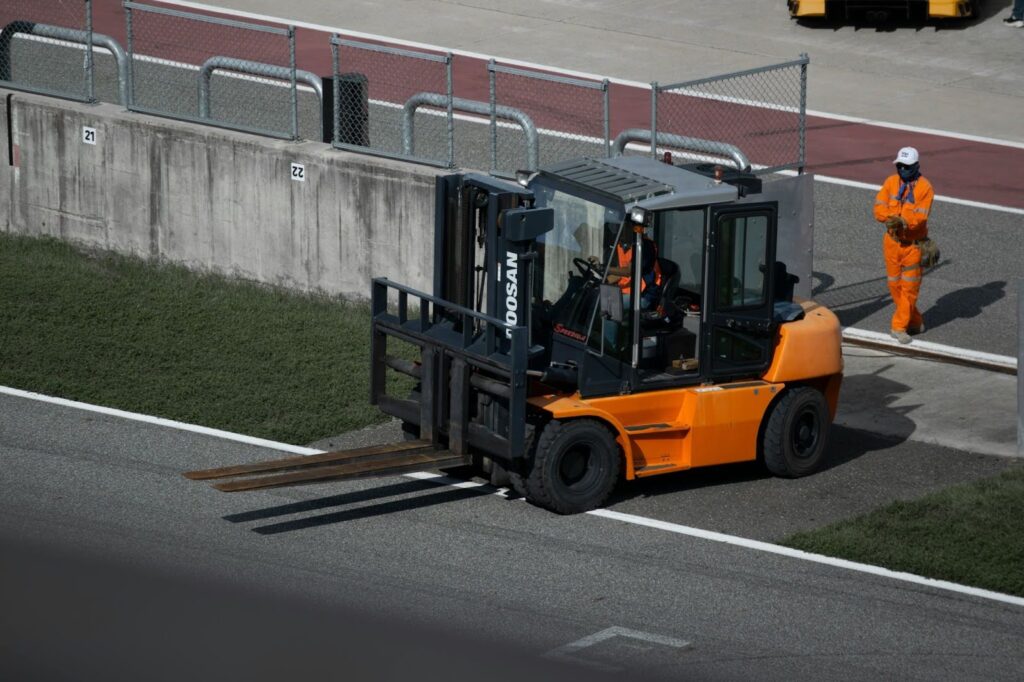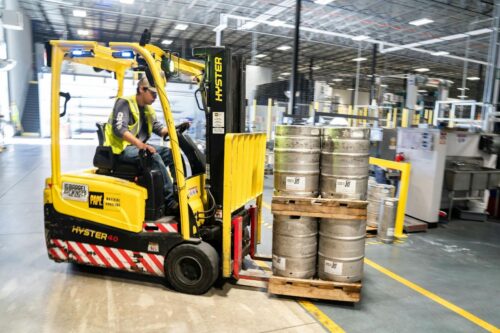What is a Counterbalance Forklift? Definition, Types, and Uses

Counterbalance forklifts are vital machines in commercial shipping, offering versatility and efficiency in handling heavy loads. Whether using an electric forklift for indoor applications or a diesel-powered model for outdoor tasks, these forklifts are designed to meet various operational needs.
Forklifts are essential machines in commercial shipping and logistics. They help move heavy loads efficiently within warehouses and loading docks. Among the various types, the counterbalance forklift stands out as the most common type of forklift truck.
The global forklift market is expected to reach $81.39 billion by 2027, highlighting the importance of these machines in various industries. A counterbalance forklift is designed to lift and transport heavy loads with ease. It is known for its versatility and reliability in different environments.
In this blog, we will explore what is a counterbalance forklift, its functionality, uses, and comparisons to other forklifts.
Understanding Counterbalance Forklifts
Counterbalance forklifts are essential in commercial shipping and logistics. These forklift trucks have a straightforward design with forks extending from the front and a counterweight at the rear. This setup ensures stability when lifting and transporting heavy loads.
A counterbalance forklift differs from other types of forklifts in its structure and weight distribution. Unlike a reach truck, it uses a counterweight to offset the load, making it ideal for various industries.
These forklifts are versatile and can operate efficiently in tight spaces and on smooth surfaces. Let’s discuss the different types of forklifts in detail:
1. Propane Forklifts
Propane forklifts are powerful and efficient. They use propane gas and can operate continuously over multiple shifts with quick refueling. They are best suited for outdoor or well-ventilated environments due to emissions and are effective in handling heavy loads.
2. Electric Forklifts
Electric forklifts produce lower emissions and operate quietly, making them ideal for indoor use. These battery-powered machines have lower operational costs and require less maintenance. Electric counterbalance forklifts are perfect for navigating tight spaces and smooth surfaces.
3. Diesel Forklifts
Diesel-powered counterbalance forklifts are robust and efficient for heavy-duty tasks. Their diesel engines provide high torque, suitable for moving heavy loads in outdoor environments. They are designed to handle uneven terrains with pneumatic tires, making them ideal for demanding operations.
Common Uses of Counterbalance Forklifts

Counterbalance forklifts are highly versatile and commonly used in various settings such as warehouses, manufacturing facilities, and loading docks. Their ability to maneuver and lift different loads is essential in these environments.
In warehouses, counterbalance forklifts handle heavy loads and navigate narrower aisles efficiently. In manufacturing, they transport materials and products, ensuring smooth production processes.
At loading docks, they lift and move heavy-weight cargo with ease, making them indispensable for truck loading and unloading operations.
Advantages of Counterbalance Forklifts
Counterbalance forklifts offer numerous benefits, making them a popular choice across a variety of industries. Here are the key advantages:
- Versatility: Counterbalance forklifts handle different types of loads, from box clamps to carpet poles, making them adaptable to various tasks.
- Ease of Operation: These forklifts are user-friendly, and equipped with hydraulic levers and foot pedals, ensuring smooth and efficient operation for operators.
- Indoor and Outdoor Use: Suitable for both indoor applications and outdoor environments, counterbalance forklifts offer flexibility in diverse settings.
- High Lift Capacity: They have a significant lift capacity, allowing them to handle heavy loads and extra weight with stability and control.
- Variety of Power Options: Available in electric, propane, and diesel-powered versions, they cater to different operational needs and preferences.
- Maneuverability: With features like the inching brake, counterbalance forklift trucks can easily navigate narrower aisles and tight spaces.
- Durability: Designed for heavy-duty use, they are robust and reliable, capable of withstanding rigorous tasks in demanding environments.
Comparison to Other Types of Forklifts
Counterbalance forklifts are versatile and widely used, but other types of forklifts serve specific purposes and offer unique benefits. Here, we compare counterbalance forklifts with reach trucks, side loaders, and pallet jacks.
Reach Trucks
Reach trucks are designed for lifting in narrow aisles and high warehouse shelves. Unlike counterbalance forklifts, reach trucks have an extendable fork that can reach into racking systems.
They have a higher lift capacity and are ideal for environments with limited space. Reach trucks are more agile in confined spaces but are less versatile for outdoor use compared to counterbalance models.
Side Loaders
Side loaders are specialized forklifts used for handling long loads like timber and pipes. They lift and carry loads on the side of the vehicle, allowing them to navigate narrow aisles and tight spaces efficiently.
This type of forklift is different from counterbalance forklifts, which lift loads from the front. Side loaders are particularly useful in warehouses and industrial settings where long materials need to be moved.
Pallet Jacks
Pallet jacks are the most basic type of forklift, designed for moving pallets over short distances. They have a lower lift capacity and are manually operated or electric. Unlike counterbalance forklifts, pallet jacks are not suitable for lifting heavy loads to high heights. However, they are perfect for indoor applications and tasks that require minimal lifting.
Safety Considerations for Operating Counterbalance Forklifts
Operating a counterbalance forklift safely requires proper training and guidance about safety measures, and regular maintenance. Operators should understand the machine and its controls, including the three hydraulic levers, inching brakes, and foot pedals.
Routine checks are essential. Inspect the forks, tire type, and weight capacity. Ensure extra batteries for electric counterbalance forklifts are charged. Common hazards include overloading and poor weight distribution. Always adhere to load limits and ensure clear visibility when operating the forklift.
Choosing the Right Forklift for Your Needs
To choose the right forklift, assess your load capacity needs. For heavy loads, consider a diesel-powered counterbalance forklift or a propane counterbalance forklift. For indoor use, an electric counterbalance forklift is ideal.
Evaluate the height of the lift required and the tire type for your terrain. Pneumatic tires suit rough surfaces, while cushion tires are best for indoor floors. Consider if extra batteries are needed for electric versions to support multiple shifts.
Conclusion
Counterbalance forklifts are vital machines in commercial shipping, offering versatility and efficiency in handling heavy loads. Whether using an electric forklift for indoor applications or a diesel-powered model for outdoor tasks, these forklifts are designed to meet various operational needs.
With features like the inching brake, foot pedal, and robust two forks, they ensure safe and effective material handling.
Now that you understand what is a counterbalance forklift and its benefits, you can confidently choose the right forklift for your warehouse, medicine production, or any other industry-specific requirements.
